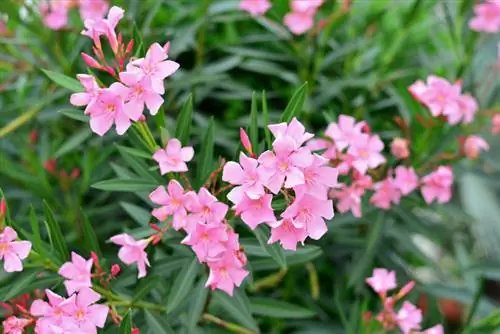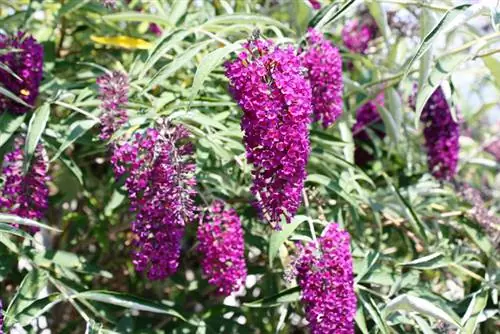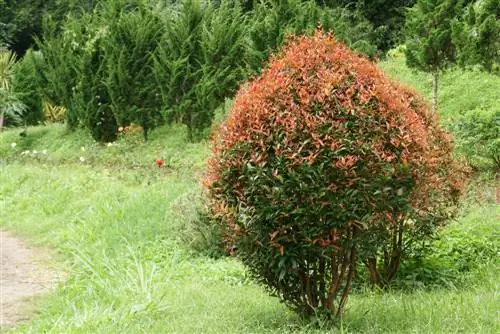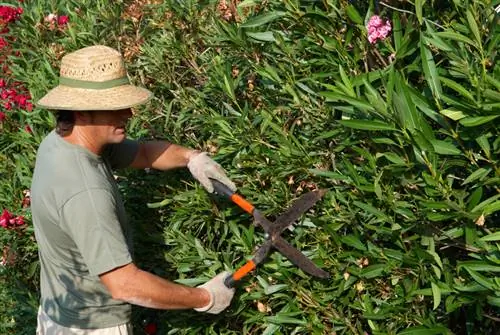- Author admin [email protected].
- Public 2023-12-16 16:46.
- Last modified 2025-01-23 11:20.
The oleander (Nerium oleander) is a heavy feeder and therefore has an exceptionally high nutrient requirement - rather a rarity among Mediterranean plants, which are usually used to poor soils. However, the oleander naturally thrives on frequently flooded river banks, where they are richly supplied with washed-up nutrients. Therefore, you should not only water the oleander frequently, but also fertilize it at least once a week.

How do you fertilize oleander correctly?
Oleander needs regular fertilization with slow-release fertilizer, flowering plant or oleander fertilizer, usually once a week, from March to August. Potash fertilizer also supports winter resistance. Coffee or tea grounds and organic fertilizers such as compost are also suitable.
Fertilize oleander during the growing season
During the winter months, the oleander needs to be watered, but not fertilized: the evergreen plant needs a break in the cold season and should therefore be kept as cool as possible over the winter. Start regular fertilization at the beginning of the growing season in March and continue until mid, but at most the end of August. After that, the oleander should no longer be supplied with nutrients so that the shoots can mature in time before the winter break - this gives the plant, which is only winter-hardy down to around minus five degrees Celsius, a certain degree of protection from cold temperatures. Ultimately, oleander should be moved to winter quarters as late as possible.
Potassium fertilizer and lime are also good for oleander
You can also increase winter hardiness by supplying the oleander with potash fertilizer between mid and late August. This supports the shoots in maturing in a timely manner, but must not be used later than specified. Otherwise it can no longer be effective. Even in spring, an additional application of potash fertilizer and lime fertilizer at the beginning of the growing season makes sense, especially if you fertilize with slow-release fertilizer.
Which fertilizer is suitable for oleander?
Oleander can be effectively supplied with a variety of fertilizers and tolerates both mineral and organic substances very well.
For the forgetful: slow-release fertilizer lasts a long time
If you are forgetful or just want to be on the safe side, provide your oleander with a long-term fertilizer for flowering plants at the beginning of the growing season. There are various remedies available on the market that cover three, four, six or even twelve months. Fertilize the oleander at the beginning of the season and carefully work the fertilizer into the substrate. You will then have peace and quiet for the specified period of time; over-fertilization is also difficult - due to the nutrients being released very slowly. Even after or when repotting, the oleander should be provided with a long-term fertilizer.
Weekly flowering plant or oleander fertilizer
Alternatively, fertilization with a mineral flowering plant or special oleander fertilizer is of course also possible, but this should be carried out once or twice a week - depending on the product used. It is best to use a liquid fertilizer that you can administer together with the irrigation water. This has the advantage that it reaches the roots more quickly and can be absorbed better.
Oleander tolerates organic fertilizers very well
If you like it more natural, you can of course also use natural fertilizers such as compost, manure and horn shavings. These fertilizers also release their nutrients very slowly, making over-fertilization practically impossible. Provide your oleander with organic fertilizer in early spring and early summer, which is thoroughly worked into the substrate. When repotting (do this in early spring if possible!), the planting substrate can be enriched with compost and horn shavings.
Extra tip: Fertilize oleander with tea or coffee grounds
A very special and particularly inexpensive insider tip for fertilizing heavy-feeding plants such as oleander is to use tea or coffee grounds. Coffee grounds in particular contain a lot of valuable nutrients and are a valuable fertilizer, which is also produced free of charge in many households - and is usually thrown away. You can use coffee grounds fresh, but you can also dry them and then store them in an airtight container for the next use.
Fertilize oleander with blue seed
It is also possible to fertilize oleander with blue grain; many hobby gardeners have had very good experiences with this. However, with the very nitrogen-containing blue grain, over-fertilization can quickly occur, which stimulates shoot growth immensely, but hardly any flowers are formed - too much nitrogen in the fertilizer is poisonous for abundant flowers. However, when dosed correctly (be sure to follow the instructions!), you can't go wrong with Blaukorn. If you want to be on the safe side, you can also fertilize your oleander with compost at the beginning of the growing season - this ensures a balanced mineral balance.
Identify nutrient deficiencies early on
Sure signs of a lack of fertilization are yellow leaves - especially if the oleander not only has a few yellow leaves, but a lot of leaves turn yellow within a short period of time. However, isolated yellow leaves are normal; this is a natural aging of the foliage. Measly flowers or stunted flowers can also indicate a nutrient deficiency; these often occur in combination with fungal or bacterial diseases.
Tip
Especially with mineral fertilizers, you should definitely follow the manufacturer's dosage instructions to avoid over-fertilization. However, if you mean too well, this is not necessarily fatal. Pay attention to the leaf edges: If these become brown and dry, you should reduce the amount and/or frequency of fertilizing or switch to a different fertilizer. Unfortunately, these leaf edge necroses remain visible for a very long time.






